| CONTENTS
SECTION I - THE ESTIMATES IN
THE CONTEXT OF THE ECONOMY
Relationship between Government Expenditure,
Public Expenditure and GDP in 2002-2003
SECTION II - ANALYSIS OF
RECURRENT PUBLIC/GOVERNMENT EXPENDITURE BY POLICY AREA GROUP
Recurrent Public Expenditure - Year on Year Change
Commentary on the Changes
Growth in Major Policy Area Groups
Percentage Share of Expenditure by Policy Area Group -
Recurrent Public Expenditure
Recurrent Government Expenditure
SECTION III - ANALYSIS OF
TOTAL PUBLIC/GOVERNMENT EXPENDITURE BY POLICY AREA GROUP
Total Public Expenditure - Year on Year Change
Commentary on the Changes
Percentage Share of Expenditure by Policy Area Group -
Total Public Expenditure
Total Government Expenditure
SECTION IV - MAJOR CAPITAL PROJECTS TO BEGIN
IN 2002-2003
SECTION V - TRENDS IN PUBLIC EXPENDITURE : 1997-1998 TO 2002-2003
SECTION VI - KEY TO CLASSIFICATION OF EXPENDITURE
SECTION I - THE ESTIMATES(Note) IN
THE CONTEXT OF THE ECONOMY
Relationship between Government Expenditure, Public Expenditure and GDP in 2002-2003
|
(All figures in $million at 2002-2003 prices)
|
|
Government
Expenditure |
Public
Expenditure
|
| General Revenue Account |
|
|
|
|
|
|
|
211,360
|
211,360
|
|
|
|
|
|
4,160
|
4,160 |
|
________ |
________ |
|
|
|
|
215,520
|
215,520 |
|
|
|
Capital Works Reserve Fund
|
34,360 |
34,360 |
|
|
|
Loan Fund
|
3,810 |
3,810 |
|
|
|
Innovation and Technology Fund
|
560 |
560 |
|
________ |
________ |
|
|
|
|
254,250
|
254,250 |
|
________ |
|
|
|
|
Trading Funds
|
|
3,520 |
|
|
|
Lotteries Fund
|
|
1,370 |
|
|
|
Housing Authority
|
|
28,040 |
|
|
________ |
|
|
|
|
|
287,180
|
|
|
________ |
|
|
|
GDP
|
|
1,256,210
|
|
|
|
| Government Expenditure as a % of GDP |
|
20.2% |
|
|
|
| Public Expenditure as a % of GDP |
|
22.9% |
|
|
|
| Note : |
The 2002-2003 expenditure estimates in this
Appendix have assumed a 4.75% reduction in the salaries of the civil
service and the salary-related portion of recurrent subventions to take
effect from 1 October 2002. |
|
|
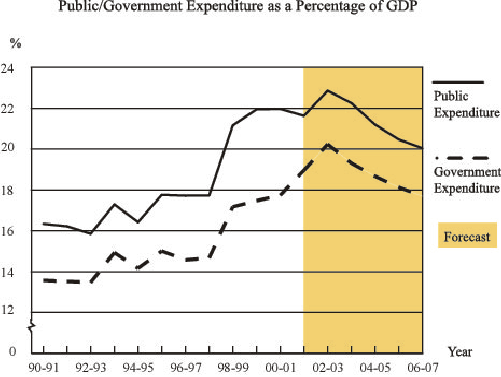
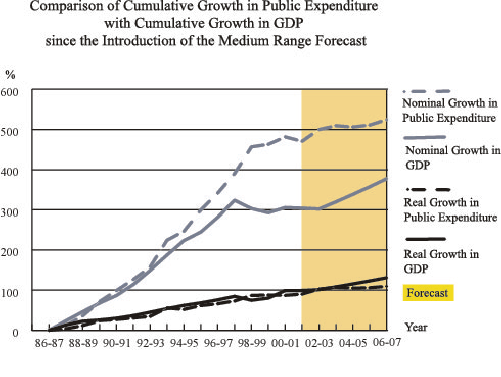
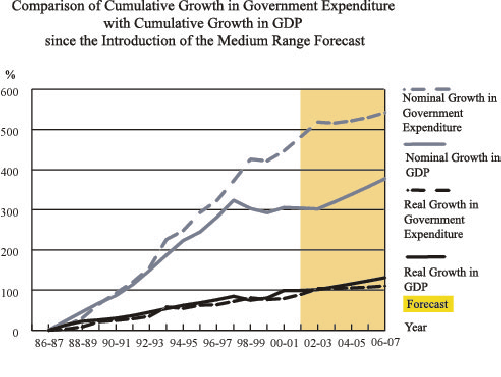
SECTION II - ANALYSIS OF
RECURRENT PUBLIC/GOVERNMENT EXPENDITURE BY POLICY AREA GROUP
Recurrent Public Expenditure - Year on Year Change
|
(All figures in $million)
|
|
2001-2002 |
2002-2003 |
Increase |
%Increase/Decrease
|
|
Revised
Estimate |
Estimate |
|
in Nominal
Terms |
in Real
Terms |
|
|
|
|
|
(see Note) |
Education
|
46,380 |
49,315 |
+2,935 |
+6.3 |
+8.0 |
Health
|
32,030 |
32,450 |
+420 |
+1.3 |
+3.6 |
Social Welfare
|
29,640 |
32,125 |
+2,485 |
+8.4 |
+9.0 |
Support
|
|
|
|
|
|
- Central Management of the Civil Service
|
18,800 |
18,170 |
-630 |
-3.4 |
-3.3 |
|
|
10,360 |
10,260 |
-100 |
-1.0 |
+0.5 |
|
______ |
______ |
______ |
______ |
______ |
|
|
|
|
|
|
|
29,160 |
28,430 |
-730 |
-2.5 |
-1.9 |
|
______ |
______ |
______ |
______ |
______ |
|
|
|
|
|
|
Security
|
24,900 |
24,810 |
-90 |
-0.4 |
+1.8 |
Housing
|
12,615 |
12,235 |
-380 |
-3.0 |
-1.8 |
Infrastructure
|
|
|
|
|
|
|
|
5,380 |
5,505 |
+125 |
+2.3 |
+2.6 |
- Buildings, Lands and Planning
|
3,225 |
3,330 |
+105 |
+3.3 |
+5.3 |
|
|
2,985 |
3,105 |
+120 |
+4.0 |
+5.5 |
|
______ |
______ |
______ |
______ |
______ |
|
|
|
|
|
|
|
11,590 |
11,940 |
+350 |
+3.0 |
+4.1 |
|
______ |
______ |
______ |
______ |
______ |
|
|
|
|
|
|
Economic
|
11,095 |
11,825 |
+730 |
+6.6 |
+8.3 |
Environment and Food
|
8,345 |
9,005 |
+660 |
+7.9 |
+9.6 |
| Community and External Affairs |
|
|
|
|
|
|
|
|
|
|
|
|
|
5,650
|
5,660
|
+10
|
+0.2
|
+1.4
|
|
|
1,815
|
1,910
|
+95
|
+5.3
|
+6.4
|
|
______ |
______ |
______ |
______ |
______ |
|
|
|
|
|
|
|
7,465
|
7,570 |
+105 |
+1.5 |
+2.6 |
|
______ |
______ |
______ |
______ |
______ |
|
|
|
|
|
|
| Total Recurrent Public Expenditure |
213,220 |
219,705 |
+6,485 |
+3.0 |
+4.5 |
|
_______ |
_______ |
_______ |
_______ |
_______ |
|
|
|
|
|
|
|
|
|
|
|
|
| Note : |
As the above 2002-2003 estimate has included
assumptions on price changes for various expenditure components (e.g.
operating expenses, plant and equipment, etc.) and an assumed reduction
of 4.75% in salaries for the civil service and salary-related portion of
recurrent subventions, the % increase/decrease is calculated after
adjustment to bring the expenditure figures for 2001-2002 and 2002-2003 to
the same price level.
|
Recurrent Public
Expenditure - Commentary on the Changes
Recurrent
public expenditure is expected to grow by $6,485 million, or 4.5% in real terms
over the revised estimate for 2001-2002.
Within this overall growth, recurrent government expenditure will
increase by $6,925 million, or 5.0% in real terms over the revised estimate for
2001-2002.
This level of year-on-year growth in recurrent government expenditure is
partly attributable to expenditure in 2001-2002 being lower than the original
estimate, reflecting significant efforts on the part of Controlling Officers to
control costs.
The growth in recurrent government expenditure in 2002-2003 over the
original estimate for 2001-2002 will be $1,895 million, or 2.4% in real terms.
The
significant changes in recurrent public expenditure in real terms by policy area groups are:
Support
(-1.9%)
The
decrease mainly reflects the reduced requirement on pension payment under the
Voluntary Retirement Scheme due to the decreased number of
officers retiring in 2002-2003 as compared to 2001-2002 as the scheme tapers
off.
Housing
(-1.8%)
The
decrease reflects the reduced expenditure of the Housing Authority.
Infrastructure
(+4.1%)
The
increase mainly arises from additional spending on stepped up efforts to remove
unauthorised building works and structures; on large scale clearance operations; on operation and maintenance of
additional waterworks installations; and on road maintenance and management of
public transport interchanges.
Economic
(+8.3%)
The increase mainly arises from the provision of recurrent funding to
expenditure initiatives on employment/training.
Environment
and Food
(+9.6%)
The
increase reflects additional spending on monitoring food safety; on
managing construction and demolition materials; on enhancing waste
reduction and recovery; on enhancing cleanliness of Hong Kong; and on
operating new sewage treatment facilities.
Community
and External Affairs
(+2.6%)
The increase reflects the additional provision on district and community
relations; management of more major recreation, culture and amenities
facilities; active planting in urban area and countryside; and grants to
organise youth development programmes.
The
major improvements in services in 2002-2003 in Education, Health, Social Welfare
and Security policy area groups are detailed below :
Recurrent
Public Expenditure - Growth in Major Policy Area Groups
The
key improvements contributing to the real growth in recurrent public expenditure in Education,
Health, Social
Welfare and Security are detailed below:
| Education
(+8.0%)
|
|
|
| — |
Additional
resources to support curriculum reform, including 249 additional primary school teachers
for five years to serve as curriculum leaders |
|
|
| — |
Native-speaking English Teachers and English Language Teaching Assistants for
primary schools
|
|
|
| — |
IT Co-ordinators for primary and secondary schools in the next two school
years
|
|
|
| — |
Cash grants to strengthen student guidance service in primary schools
|
|
|
| — |
Operating about 40 more primary schools on whole-day basis
|
|
|
| — |
Improving and rationalising various student financial assistance schemes
|
|
|
| — |
Implementing financial assistance schemes for students to support the
expansion of post-secondary
education
|
|
|
| — |
Enhancing the Kindergarten Subsidy Scheme to encourage kindergartens to
recruit more qualified kindergarten teachers
|
|
|
| — |
Additional training places for serving kindergarten principals and child care
centre supervisors
|
|
|
| — |
Enhancing school-based educational psychology service for primary schools
|
|
|
| — |
Extending the Smart Teen Challenge Project to more students for four school
years
|
|
|
| — |
Strengthening the support for subject-related teacher organisations
|
|
|
| Health
(+$3.6%)
|
|
|
| — |
Opening
net 166 additional hospital beds |
|
|
| — |
Opening 80 additional day hospital places |
|
|
| — |
Employing 1 000 additional care assistants to strengthen extended care
service in hospitals
|
|
|
| — |
Introducing
an intensive rehabilitation and treatment programme for psychiatric patients
to facilitate their early integration into the community |
|
|
| — |
Launching
an adolescent health programme, developing a cervical screening programme,
piloting a men's health programme, and implementing a parenting programme |
|
|
| — |
Opening
a Primary Health Care Centre in Fanling with a maternal and child health
centre,
a child assessment centre, a school dental clinic, and an integrated day
treatment centre
|
|
|
| Social
Welfare (+9.0%) |
|
|
| — |
An
additional 2 702 subsidised residential places, 10 social centres (including 6
in multi-service centres), 3 multi-service
centres, 280 day care centre places and enhanced home and community care services for the elders |
|
|
| — |
An
additional 185 residential places, 135 day places, 40 early education and training
centre places, 40 special child care centre places and
13 additional home-based training teams for the disabled |
|
|
| — |
An
additional 500 day nursery places, 2 occasional child care units, 90 foster care
places and 1 refuge centre for women |
|
|
| — |
An
additional 12 integrated teams for young people |
|
|
| — |
47
additional speech therapists for pre-school disabled children |
|
|
| — |
3
additional school social workers for new schools, 150 peer counsellors and 154 Understanding the Adolescent Projects
in secondary schools |
|
|
| — |
Additional
time-limited jobs to strengthen various services including those under the
Promoting Self-reliance Strategy, services for the elders, family and
child services and rehabilitation services
|
|
|
| Security
(+1.8%)
|
|
|
| — |
133
additional police officers for strengthening operational front-line capability
and traffic enforcement in new towns
and new infrastructures |
|
|
| — |
19
additional police officers for strengthening crime detection capability |
|
|
| — |
127
additional fire fighting and ambulance officers for manning new fire stations, ambulance depots and fire
motorcycles |
|
|
| — |
50
additional ambulance officers for implementing full paramedic ambulance service |
|
|
| — |
11
additional staff in Fire Services Department for implementing the Railway
Development Strategy
and formulating the fire services requirement for Hong Kong Disneyland |
|
|
| — |
33
additional staff in Independent Commission Against Corruption for enhancing investigative capability, strengthening information
technology support services and improving the handling of case properties |
|
|
| — |
121
additional customs officers for manning customs facilities at Container Terminal
No. 9 and for facilitating
cross boundary traffic at Lok Ma Chau and Lo Wu Control Points |
|
|
| — |
10
additional staff in Correctional Services Department for implementing the new
Rehabilitation Centres Programmes
for young offenders |
|
|
| — |
10
additional correctional services officers for strengthening escort service to
implement the proposal of shortening the maximum
remand period from eight to three days |
|
|
| — |
93
additional immigration officers for strengthening immigration
control at boundary control points |
|
|
| — |
30
additional staff in Immigration Department for implementing the new Registration
of Persons System which supports the issue of
smart identity card |
|
|
| — |
32
additional staff in Immigration Department for implementing Phase I of the
updated Information Systems Strategy |
|
|
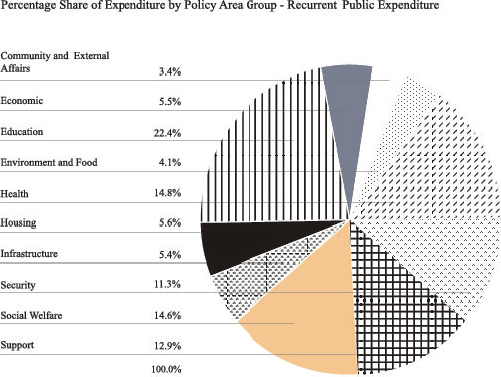
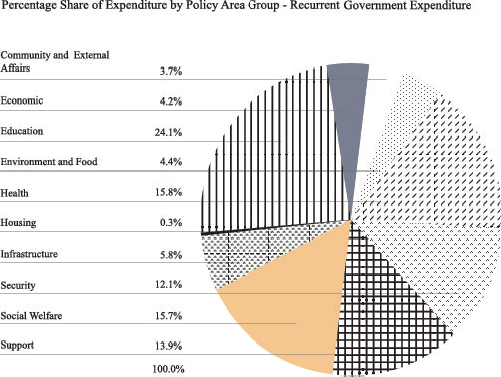
SECTION III - ANALYSIS OF
TOTAL PUBLIC/GOVERNMENT EXPENDITURE BY POLICY AREA GROUP
Total Public Expenditure -
Year on Year Change
|
(All figures in $million)
|
|
2001-2002
|
2002-2003
|
Increase
|
%Increase/Decrease
|
|
Revised
Estimate |
Estimate |
|
in Nominal
Terms |
in Real
Terms |
|
|
|
|
|
(see Note) |
Education
|
52,600 |
61,395 |
+8,795 |
+16.7 |
+18.5 |
Support
|
|
|
|
|
|
|
|
14,960 |
16,870 |
+1,910 |
+12.8 |
+14.1 |
- Central Management of the Civil Service
|
20,750 |
19,580 |
-1,170 |
-5.6 |
-5.4 |
|
______ |
______ |
______ |
______ |
______ |
|
|
|
|
|
|
|
35,710 |
36,450 |
+740 |
+2.1 |
+2.8 |
|
______ |
______ |
______ |
______ |
______ |
|
|
|
|
|
|
|
Health
|
34,015
|
34,410
|
+395
|
+1.2
|
+3.4
|
|
Social Welfare
|
30,730
|
33,740
|
+3,010
|
+9.8
|
+10.4
|
|
Housing
|
33,185
|
28,735
|
-4,450
|
-13.4
|
-13.0
|
|
Security
|
28,065
|
28,600
|
+535
|
+1.9
|
+4.0
|
|
Infrastructure
|
|
|
|
|
|
- Buildings, Lands and Planning
|
10,840 |
10,590 |
-250 |
-2.4 |
-1.8 |
|
|
7,765 |
7,435 |
-330 |
-4.3 |
-3.8 |
|
|
6,335 |
7,365 |
+1,030 |
+16.4 |
+17.3 |
|
______ |
______ |
______ |
______ |
______ |
|
|
|
|
|
|
|
24,940 |
25,390 |
+450 |
+1.8 |
+2.4 |
|
______ |
______ |
______ |
______ |
______ |
|
|
|
|
|
|
Economic
|
14,100 |
17,140 |
+3,040 |
+21.6 |
+23.5 |
Environment and Food
|
11,330 |
12,480 |
+1,150 |
+10.2 |
+11.7 |
| Community and External Affairs |
|
|
|
|
|
|
|
|
|
|
|
- Recreation, Culture and Amenities
|
6,525 |
6,470 |
-55 |
-0.8 |
+0.4 |
- District and Community Relations
|
1,950 |
2,370 |
+420 |
+21.4 |
+22.6 |
|
______ |
______ |
______ |
______ |
______ |
|
|
|
|
|
|
|
8,475
|
8,840 |
+365 |
+4.3 |
+5.5 |
|
______ |
______ |
______ |
______ |
______ |
|
|
|
|
|
|
| Total Public Expenditure |
273,150 |
287,180 |
+14,030 |
+5.1 |
+6.5 |
|
_______ |
_______ |
_______ |
_______ |
_______ |
|
|
|
|
|
|
| Note : |
As the above 2002-2003 estimate has included
assumptions on price changes for various expenditure components (e.g.
operating expenses, plant and equipment, etc.) and an assumed reduction
of 4.75% in salaries for the civil service and salary-related portion of
recurrent subventions, the % increase/decrease is calculated after
adjustment to bring the expenditure figures for 2001-2002 and 2002-2003 to
the same price level.
|
Total Public
Expenditure - Commentary on the Changes
Total
public expenditure is forecast to
grow in 2002-2003 by $14,030 million, or 6.5% in real terms over the revised
estimate for 2001-2002.
Within this, government
expenditure will grow by $14,905 million, or 7.7% in real terms. The growth
in government expenditure comprises growth in recurrent expenditure of $6,925
million or 5.0%, and growth in capital expenditure of $7,980 million or 20.5%.
Expenditure from the Capital Works Reserve Fund, which makes up the
majority of capital expenditure, is forecast to grow by $4,740 million or 16.3%
in real terms.
The
significant changes in capital expenditure contributing to the growth in total
public expenditure are:
Education
(+$8,795
million)
Capital spending on Education will rise by $5,860
million, or 97% in real terms, reflecting provision for the setting up of the
Continuing Education Fund, additional loans to students pursuing higher
education and additional loans to post-secondary education providers, and
additional expenditure on the continuing programme of school-building and
improvement works, University
Grants Committee - funded building projects, capital payments to subvented
primary and secondary schools for maintenance, repairs and minor improvement
works, and enhancement to the information technology infrastructure for schools
and the Education Department.
Support
(+$740 million)
Capital
spending in this policy area group is forecast to rise by $1,470 million or
23.7% in real terms.
The increase reflects additional provision for various minor works for
items in Category D of the Public Works Programme.
Health
(+$395 million)
Capital spending on Health is forecast to reduce by $25 million, reflecting the
near completion of a number of redevelopment hospital projects in 2002-2003.
Social
Welfare
(+$3,010 million)
Capital spending on Social Welfare is forecast to rise by $525 million or
48.6% in real terms. The increase
reflects additional spending under the Lotteries Fund for various social welfare
non-recurrent grants.
Housing
(-$4,450 million)
The
reduction mainly reflects the forecast capital expenditure of the Housing
Authority in 2002-2003
Security
(+$535 million)
Capital spending on Security is forecast to rise
by $625 million or 21.9% in real terms. This reflects the planned expenditure on
the redevelopment of Police Headquarters, and on implementation of the HKSAR
Identity Card Project and an updated Information Systems Strategy for the
Immigration Department.
Infrastructure
(+$450 million)
Capital spending on Infrastructure is expected to rise by $100 million or
1.0% in real terms. This arises
mainly from increased expenditure on supporting infrastructure works for Hong
Kong Disneyland, Container Terminal No.9 and road works.
Economic
(+$3,040 million)
Capital
spending in this policy area group will rise by $2,310 million or 79.6% in real
terms, reflecting additional funding support for innovation and technology,
including planned expenditure on the Science Park at Pak Shek Kok; funding for 4
new funding schemes for small and medium enterprises; and additional provision
to Skills Upgrading Scheme.
Environment
and Food (+$1,150 million)
Capital spending in this policy area group will
increase by $490 million or 17.5% in real terms.
This reflects provision for new and improvement works for market
complexes and various sewerage and sewage treatment works.
Community
and External Affairs (+$365
million)
Capital spending in this policy area group will rise by $260 million or
26.8% in real terms, reflecting additional provision for leisure and cultural
facilities; and for restoration of historical buildings.
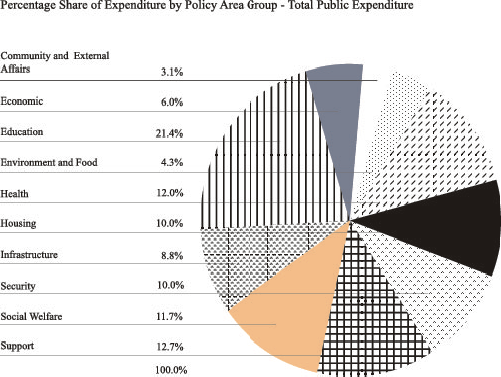

SECTION IV - MAJOR CAPITAL PROJECTS TO BEGIN
IN 2002-2003
Funds
allocated for capital projects to start in 2002-2003 include :
|
$million
|
|
|
| Infrastructure |
14,923 |
| — |
Tsuen Wan Road upgrading |
|
| — |
Investigation, design and construction of the
remaining associated infrastructure and landscaping works for the Hong
Kong Disneyland on Lantau Island |
|
| — |
Central Reclamation phase III - engineering
works |
|
| — |
Development at Anderson Road |
|
| — |
Drainage improvement - Northern Hong Kong
Island, West Kowloon, Tsuen Wan, Kwai Chung and Tsing Yi |
|
|
|
|
|
Education |
12,110 |
| — |
Construction of additional primary, secondary
and special schools |
|
| — |
School Improvement Programme, Final Phase |
|
| — |
Teaching facilities and student hostels for universities |
|
| — |
Education resource centre at Kowloon Tong |
|
|
|
|
| Environment and Food |
__ 836 |
|
— |
Central, Western, and Wan Chai West sewerage,
stage 2 phase 2 works |
|
|
— |
Yuen Long and Kam Tin sewerage, stage 3 |
|
|
|
|
| Community and External
Affairs |
819 |
|
— |
International Wetland Park
and Visitor Centre in Tin Shui Wai-phase 2 works |
|
| — |
Kowloon Bay Recreation Ground |
|
| — |
Joint-user building at Rock Hill Street, Kennedy
Town |
|
|
|
|
| Economic |
714 |
| — |
Applied Science and Technology Research
Institute |
|
|
|
|
| Health |
______590 |
|
— |
Establishment of a Radiotherapy Centre and
redevelopment of the Accident and Emergency Department in Princess
Margaret Hospital |
|
|
|
|
|
Security |
______171 |
| — |
Improvements to Lo Wu Terminal Building and Lo
Wu Footbridge |
|
|
|
|
SECTION V - TRENDS IN
PUBLIC EXPENDITURE : 1997-1998 TO 2002-2003
Introduction
The section presents trends in public expenditure over the period 1997-1998 to
2002-2003. This analysis is expressed in public expenditure terms and includes
expenditure by the Trading Funds, the Housing Authority, the Lotteries Fund and
the previous Provisional Urban Council and Provisional Regional Council (up to
31 December 1999). It shows the actual and estimated recurrent and total
expenditure during this period and expresses this in terms of ten main policy
area groups. Where appropriate, policy area groups are further analysed by
policy areas.
2 Details
of the individual heads of expenditure contributing to a particular policy area
are provided in an index in Volume I of the 2002-2003 Estimates. This index
further provides details by head of expenditure of individual programmes which
contribute to a policy area.
3 The
analysis provided in this section shows how resources have been and will, in
2002-2003, be allocated to different policy area groups. Where appropriate,
historical figures have been adjusted to comply with the current classification
of expenditure.
|
Recurrent Public Expenditure by Policy Area Group
1997-1998 to 2002-2003
|
| Policy Area Groups |
Actual |
Revised Estimate |
Estimate |
| 1997-1998 |
1998-1999 |
1999-2000 |
2000-2001 |
2001-2002 |
2002-2003 |
| % |
% |
% |
% |
% |
% |
| Education |
21.2 |
21.8 |
22.0 |
22.3 |
21.8 |
22.4 |
| Health |
15.1 |
15.3 |
15.3 |
15.4 |
15.0 |
14.8 |
| Social Welfare |
11.8 |
13.5 |
13.7 |
13.8 |
13.9 |
14.6 |
| Support |
13.4 |
11.9 |
12.2 |
12.7 |
13.7 |
12.9 |
| Security |
|
|
|
|
|
|
|
|
10.1 |
9.7 |
9.4 |
9.3 |
9.0 |
8.7 |
|
|
1.6 |
1.7 |
1.8 |
1.6 |
1.6 |
1.6 |
|
|
1.1 |
1.1 |
1.1 |
1.1 |
1.1 |
1.0 |
| |
12.8 |
12.5 |
12.3 |
12.0 |
11.7 |
11.3 |
| Housing |
6.6 |
6.3 |
6.0 |
5.8 |
5.9 |
5.6 |
| Economic |
5.8 |
5.4 |
5.2 |
5.2 |
5.2 |
5.5 |
| Infrastructure |
|
|
|
|
|
|
|
|
2.6 |
2.6 |
2.6 |
2.6 |
2.5 |
2.5 |
Buildings, Lands and Planning
|
1.4 |
1.4 |
1.5 |
1.4 |
1.5 |
1.5 |
|
|
1.4 |
1.4 |
1.5 |
1.4 |
1.4 |
1.4 |
| |
5.4 |
5.4 |
5.5 |
5.4 |
5.4 |
5.4 |
| Environment and Food |
4.3 |
4.2 |
4.2 |
4.0 |
3.9 |
4.1 |
| Community and External Affairs |
|
|
|
|
|
|
Recreation, Culture and Amenities
|
2.9 |
2.9 |
2.8 |
2.6 |
2.6 |
2.5 |
|
|
0.7 |
0.8 |
0.8 |
0.8 |
0.9 |
0.9 |
| |
3.6 |
3.7 |
3.6 |
3.4 |
3.5 |
3.4 |
| |
100.0 |
100.0 |
100.0 |
100.0 |
100.0 |
100.0 |
| Total Recurrent Public Expenditure |
$m |
$m |
$m |
$m |
$m |
$m |
| 172,419 |
187,857 |
195,272 |
198,619 |
213,220 |
219,705 |
| Total Public Expenditure by Policy Area Group
1997-1998
to 2002-2003 |
| Policy Area Groups |
Actual |
Revised Estimate |
Estimate |
| 1997-1998 |
1998-1999 |
1999-2000 |
2000-2001 |
2001-2002 |
2002-2003 |
| % |
% |
% |
% |
% |
% |
| Education |
20.0 |
18.2 |
18.7 |
19.2 |
19.3 |
21.4 |
| Support |
12.9 |
11.1 |
11.6 |
11.6 |
13.1 |
12.7 |
| Health |
11.9 |
11.8 |
11.8 |
12.2 |
12.5 |
12.0 |
| Social Welfare |
9.3 |
9.9 |
10.2 |
10.5 |
11.2 |
11.7 |
| Housing |
10.5 |
14.6 |
17.0 |
15.9 |
12.1 |
10.0 |
| Security |
|
|
|
|
|
|
|
|
8.0 |
7.3 |
7.5 |
7.8 |
8.0 |
7.8 |
|
|
1.3 |
1.3 |
0.8 |
1.4 |
1.4 |
1.3 |
|
|
0.8 |
0.8 |
1.3 |
0.8 |
0.9 |
0.9 |
| |
10.1 |
9.4 |
9.6 |
10.0 |
10.3 |
10.0 |
| Infrastructure |
|
|
|
|
|
|
Buildings, Lands and Planning
|
3.2 |
3.1 |
3.0 |
3.2 |
4.0 |
3.7 |
|
|
2.7 |
3.1 |
3.1 |
3.0 |
2.8 |
2.6 |
|
|
3.1 |
2.5 |
2.4 |
2.4 |
2.3 |
2.5 |
| |
9.0 |
8.7 |
8.5 |
8.6 |
9.1 |
8.8 |
| Economic |
7.3 |
8.0 |
4.6 |
4.7 |
5.2 |
6.0 |
| Environment and Food |
5.6 |
5.0 |
4.6 |
4.2 |
4.1 |
4.3 |
| Community and External Affairs |
|
|
|
|
|
|
Recreation, Culture and Amenities
|
2.8 |
2.7 |
2.8 |
2.4 |
2.4 |
2.3 |
|
|
0.6 |
0.6 |
0.6 |
0.7 |
0.7 |
0.8 |
| |
3.4 |
3.3 |
3.4 |
3.1 |
3.1 |
3.1 |
| |
100.0 |
100.0 |
100.0 |
100.0 |
100.0 |
100.0 |
| Total Public Expenditure |
$m |
$m |
$m |
$m |
$m |
$m |
| 234,780 |
266,448 |
269,484 |
267,507 |
273,150 |
287,180 |
| Policy Area Group |
Description by Policy Area |
Reference
(Note) |
Community and
External Affairs |
District and Community Relations |
19 |
|
| Recreation, Culture, Amenities and Entertainment Licensing |
18 |
|
|
|
|
|
| Economic |
Air and Sea Communications |
3 |
|
|
Commerce and Industry |
6 |
|
|
Employment |
8 |
|
|
Financial Services |
1 |
|
|
Information Technology, and Broadcasting |
17 |
|
|
Posts, Power, Competition
Policy and Consumer Protection |
4 |
|
|
Public Safety |
7 |
|
|
Travel and Tourism |
5 |
|
|
|
|
|
| Education |
Education |
16 |
|
|
|
|
|
| Environment and Food |
Environmental Hygiene |
32 |
|
|
Environmental Protection and Conservation |
23 |
|
|
Agriculture, Fisheries and
Food Safety |
2 |
|
|
|
|
|
| Health |
Health |
15 |
|
|
|
|
|
| Housing |
Housing |
31 |
|
|
|
|
|
| Infrastructure |
Buildings, Lands and Planning |
22 |
|
|
Transport |
21 |
|
|
Water Supply |
24 |
|
|
|
|
|
| Security |
Immigration Control |
10 |
|
|
Internal Security |
9 |
|
|
Administration of Justice |
12 |
|
|
Anti-Corruption |
13 |
|
|
Legal Administration |
11 |
|
|
Legal Aid |
20 |
|
|
|
|
|
| Social Welfare |
Social Welfare |
14 |
|
|
Women's Interest |
33 |
|
|
|
|
|
| Support |
Central Management of the Civil Service |
26 |
|
|
Complaints Against Maladministration |
30 |
|
|
Constitutional Affairs |
28 |
|
|
Intra-Governmental Services |
27 |
|
|
Revenue Collection and Financial Control |
25 |
|
|
Support for Members of the Legislative Council |
29 |
|
|
|
|
|
| Note: |
The Policy Area Reference corresponds with that used in the Index of
Policy Areas in the Estimates of Expenditure. |
|









